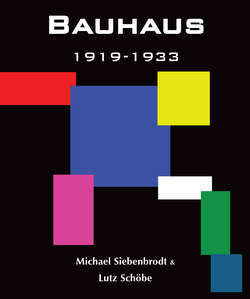Читать книгу Bauhaus. 1919-1933 - Michael Siebenbrodt - Страница 5
На сайте Литреса книга снята с продажи.
History of the Bauhaus
Forerunners, Roots and History
Ruskin, Olbrich and Others
ОглавлениеIn his 1923 essay “Idea and Construction of the Staatliches Bauhaus (State Bauhaus)”, Bauhaus founder Walter Gropius himself points to the sources which directly influenced him and the foundation of the Bauhaus. Gropius lists “Ruskin, Olbrich, Behrens, (Darmstadt Artists’ Colony) and others in Germany, then finally the Deutsche Werkbund (German Association of Craftsmen)”. In his own writings, John Ruskin (1819–1900), the English painter, art historian and social reformer, opposed the cluttered adornments of the past but also industrial production; he juxtaposed the alienating work on the machine with the ideal of the creative artisan of the Middle Ages. In his restoration efforts, which were extremely influential in England, especially in the second half of the nineteenth century, he postulated the production of things that did justice to the material, that were largely unadorned but still expressive, following the model of the Gothic style. Products made by machines, however, were “surrogates” according to him, soulless, “dead things”. It was left to the writer, designer and founder of the Socialist movement in Great Britain, William Morris (1834–1896), and the Arts and Crafts movement associated with him, to put Ruskin’s critical thoughts into practise and give further momentum to the arts and crafts reform. Morris designed novelties and interior furnishings, avoiding the misled ornamentation of the past. He and the Arts and Crafts movement saw the return to the qualities of manual trades as a way to react against the product design challenges of the Industrial Revolution. The products thus made in specially-founded arts and crafts companies were marked by simplicity, robustness, rusticity and great esteem for the material. Morris, himself a dedicated socialist, connected his design work and the associated reactivation of craftsmanship with a forced, yet illusory social assertion, which consisted of counteracting the decay of society by encouraging communal life, through joyful, manual and largely self-controlled work and the resulting good form. As a result of this, a conflict-free, blissful society should emerge, free from the rule of the machine.
Ruskin, Morris and the English Arts and Crafts movement are closely connected to the beginnings of modernist design in Europe, due to their criticism of the aesthetic appearance of machine-made products and their art reform based on the quality of the products of the manual trades. Allied with this movement were the efforts of the Scottish artist and architect Charles Rennie Mackintosh (1868–1928) and the Secession Movement in Austria with artists like Otto Wagner (1841–1918), Josef Hoffmann (1870–1956), Koloman Moser (1868–1918) and the architect mentioned by Gropius, Josef Maria Olbrich (1867–1908). Olbrich, architect of Vienna’s Secession Building, rejected the traditional, conservative concept of art, which was founded on historicism, and tested, among other things, the idea of the unified work of art by designing new, futuristic buildings and living spaces.
Shortly thereafter, Olbrich also pursued this claim with the members of the Darmstadt Artists Colony, founded in Germany in 1899, of which German architect and designer Peter Behrens (1868–1940) was also a member. Behrens was one of the most influential founders of modern industrial design and modern functional industry culture. Walter Gropius, Ludwig Mies van der Rohe and Swiss architect Le Corbusier were among his collaborators. Peter Behrens is regarded as one of the most important forerunners of functionalism, which developed into one of the most important design principles of the Bauhaus.
In Germany, Richard Riemerschmid (1868–1957) and Bruno Paul (1874–1968) were also part of the group of artists becoming industrial designers by means of their Typenmöbel (batch production furniture) designs for the Dresdner Werkstätten für Handwerkskunst (Dresden Craftsmanship Workshops). The artist Henry van de Velde (1863–1957) followed suit in Belgium and later in Germany. He tried to renew art through manual trades without rejecting technology, then turned to arts and crafts, designing functional objects for industrial production and building houses as an expression of highly-cultivated artistic individuality. Free from the ballast of historic forms, using a system of lines sensitively calculated and derived from nature in order to demonstrate in a subtle manner the structure of an object or house and its functions, the objects designed by van de Velde still did not live up to the design requirements of batch or mass production. Van de Velde, whose Grand-Ducal Saxon School of Arts and Crafts, founded in Weimar, was one of the immediate forerunners of the Staatliches Bauhaus, was regarded, like the artists previously mentioned, as one of the most important representatives of Art Deco, a movement of artists who were aware of their responsibility towards society and wanted to avoid the advancing separation of artistic and consumer culture by melding them together into a new unity. The result was an original, yet exclusive concept, which eventually could not live up to the needs of a highly-developed industrial society.
